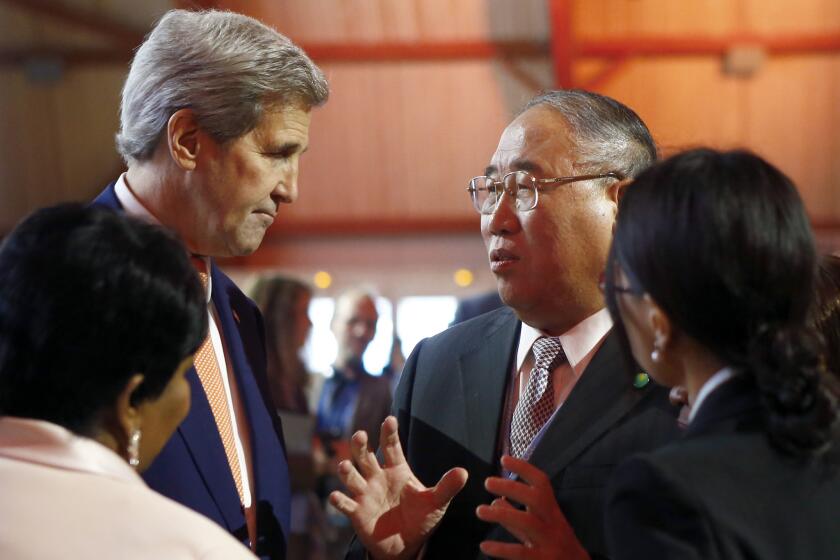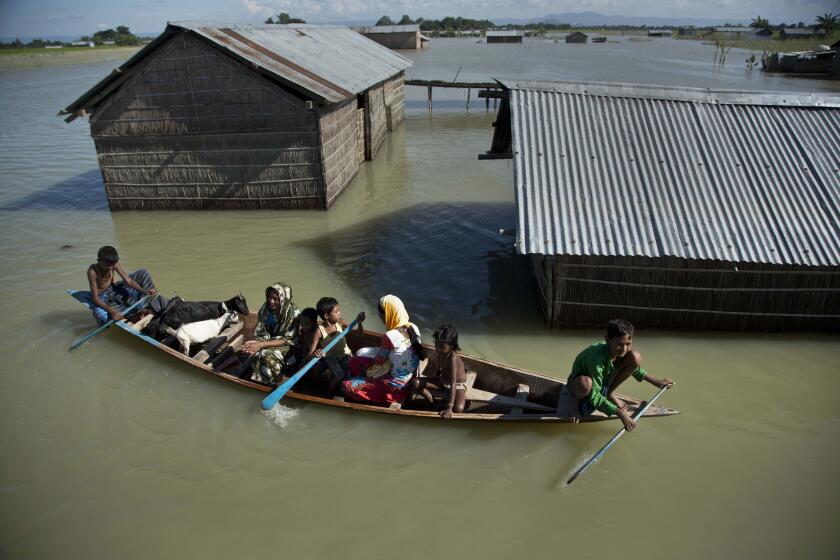What U.S.-China tension means for fighting climate change

- Share via
WASHINGTON — Six years ago, an unprecedented level of cooperation between the United States and China laid the groundwork for the Paris climate accord, a milestone in the fight against global warming.
But as final preparations are made for back-to-back international summits this week, that partnership has frayed. Dialogue between the two superpowers has been overshadowed by friction over trade, accusations of human rights violations and security issues — not to mention the domestic political and economic challenges both countries face that make working together more difficult.
Their strained relationship will be on display at the Group of 20 forum for world leaders in Rome, which starts Saturday, and the United Nations conference on climate change in Glasgow, Scotland, which begins the next day. President Biden is planning to attend both in person, while Chinese President Xi Jinping is expected to participate virtually.
Even as smog levels in Beijing often turn the sky a smoky gray, one thing was clear at the global climate change talks in Paris: China, once a laggard, emerged as a key player in the battle to help avert the worst effects of global warming.
Some experts and policymakers worry that the tension between them will jeopardize progress on climate change at a time when the catastrophic effects of rising temperatures are becoming clearer than ever. Others observe that Beijing has demonstrated a willingness to act independently of U.S. coordination, and they hope that competition between the two powers could be a positive “race to the top,” as each strives to outperform the other on reducing greenhouse gas emissions.
What’s clear, however, is that the dynamic between the U.S. and China has shifted dramatically in the last several years. “We are fundamentally in a very different era,” said Thom Woodroofe, a fellow at the Asia Society Policy Institute and former climate diplomat.
Before the Paris summit in 2015, Woodroofe said, negotiations between Washington and Beijing produced a joint announcement that was an “absolute game changer.” It signaled that China was ready to reach a deal for the first time, he said, which had a cascading effect, giving other countries confidence progress could be made.
This time around, Beijing has unrolled a series of climate announcements that appear timed to avoid seeming as if China is making changes because of U.S. pressure. Although diplomats from both countries remain in close touch, the question is whether they can spur the rest of the world to increase its ambitions without a united front of their own.
“There’s no solution to climate without the U.S. and China moving in the same direction,” said Nathaniel Keohane, president of the Center for Climate and Energy Solutions.
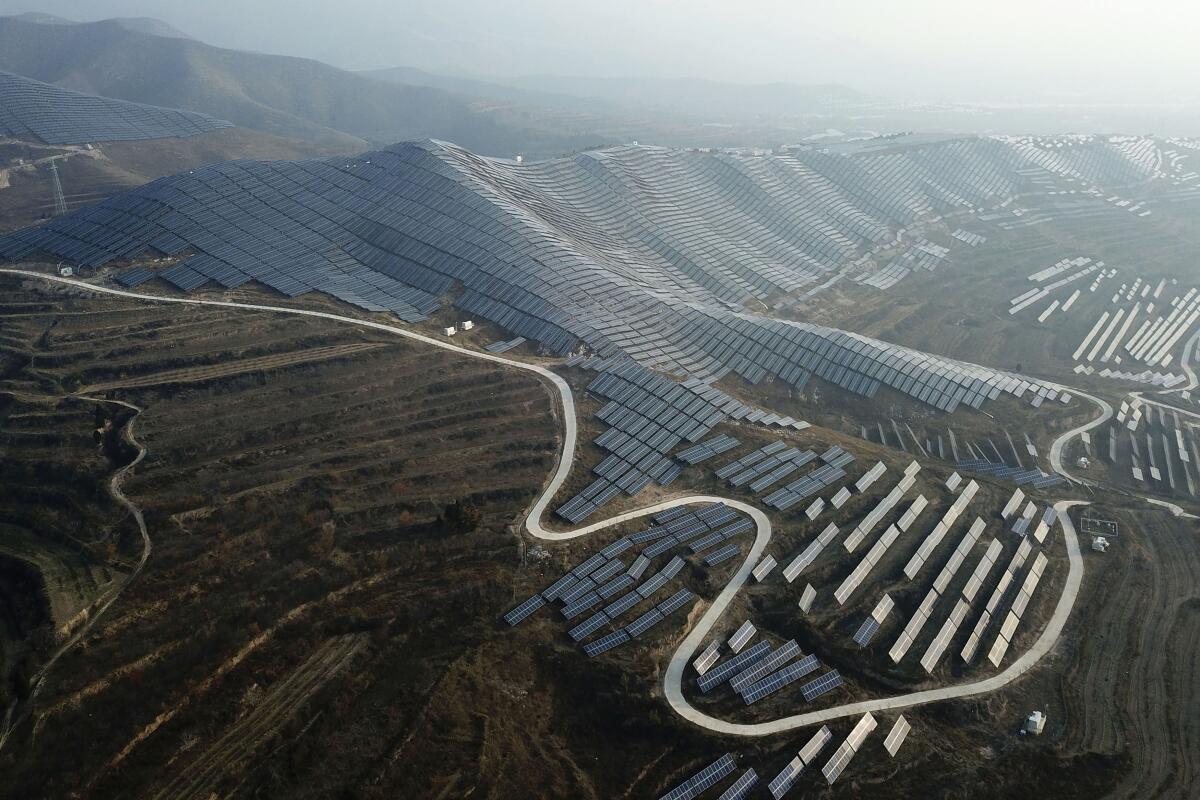
Right now, neither country is doing enough to help meet the goal of limiting global temperature rise to 1.5 degrees Celsius. Although China is a leading deployer of solar and wind power and electric vehicles, it’s the world’s top source of greenhouse gases and its biggest coal consumer.
Xi announced last year that China would reach carbon neutrality by 2060, but the country doesn’t plan to stop reducing emissions until 2030. He announced only last month that his government would stop financing coal-fired power plants around the world.
The U.S. releases more greenhouse gases per capita than any other country. Biden wants the U.S. to slash emissions to between 50% and 52% below 2005 levels by 2030, but he’s struggling to enact laws that can fulfill his pledges.
Many Chinese observers are skeptical about whether the U.S. can follow through, especially after watching former President Trump abandon the climate fight, said Li Shuo, senior climate and energy policy officer at Greenpeace China.
“The U.S. does not carry a lot of credibility, and it is not a temporary problem,” Li said. “It is systemic.”
Yet, he said, U.S. engagement can still play a role. He noted a shift in how the two countries described their roles in a joint statement this year on fighting climate change: No longer did the document refer to “common but differentiated responsibilities,” a term that had been used to place more of the burden for reducing emissions on rich nations.
“This is, in a way, China saying OK, we can shoulder, at least diplomatically, we are open to shouldering more responsibility,” Li said. He also said China probably would not have made its commitment to end its overseas financing for coal-fired plants without U.S. engagement — although Beijing pointedly waited until September to announce that rather than at a virtual summit hosted by Biden in April.
China is expected to release further domestic plans for climate change mitigation this week and to announce its short- and long-term commitments for COP26, the acronym for the summit in Glasgow. Climate advocates hope China will shift its carbon peak date up to 2025, move its carbon neutrality deadline to 2050 and announce an emissions cap. But it is unlikely Beijing will do all that, especially if it might imply any kind of kowtowing to the United States.
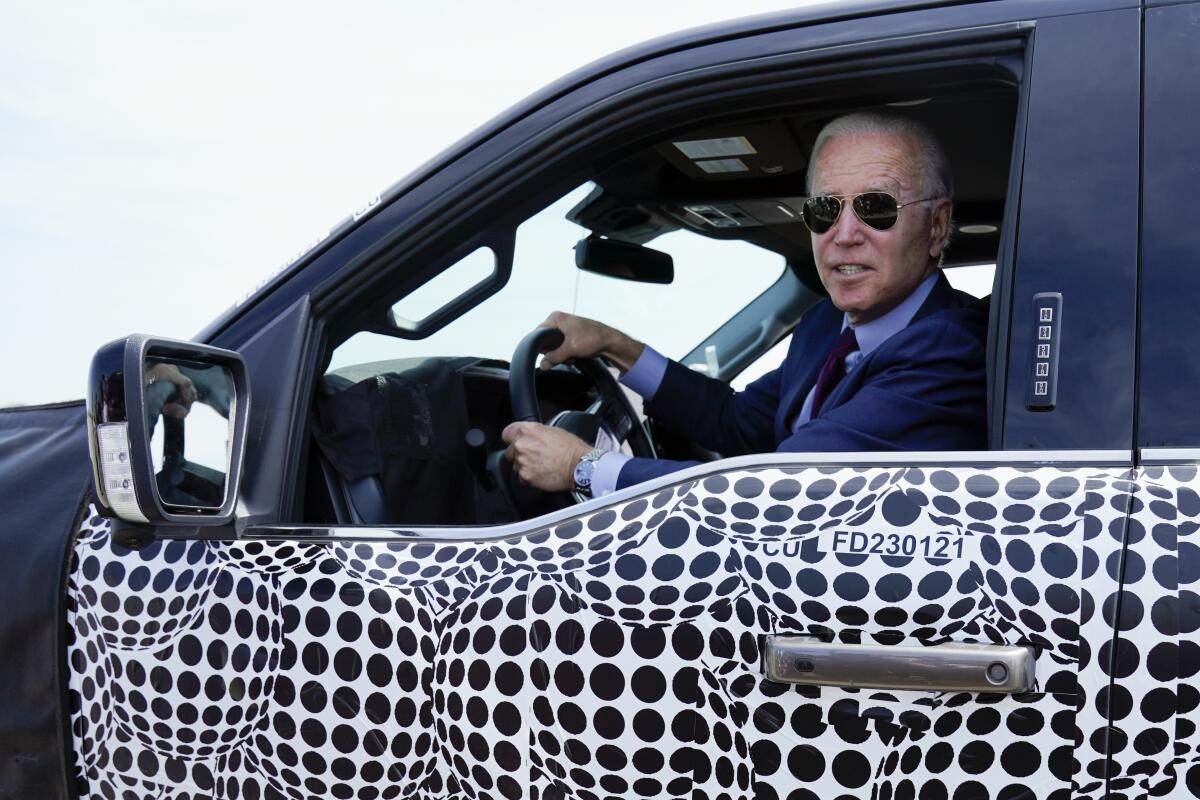
The Biden administration has sought to engage China on climate as a stand-alone issue, despite sky-high tensions between the two powers on a range of other issues, including tech, trade and the origins of the coronavirus. Biden chose former Secretary of State John F. Kerry as his global climate envoy, and Xi named Xie Zhenhua as his counterpart. The two veteran diplomats had worked closely together in the past and spoke nearly two dozen times this year.
However, the ground has shifted since the U.S. and China’s pre-Paris coordination. American politicians are more likely to be skeptical of China’s global ambitions. They harbor growing concerns about Beijing’s aggressive stance toward Taiwan, an island democracy that China considers a breakaway province, and toward the South China Sea, a key trading route.
Beijing has tried to use climate as a bargaining chip, complaining that the U.S. should not ask to cooperate on climate while pressuring China on issues such as human rights, Xinjiang, Hong Kong and Taiwan.
A new report from the federal government predicts future waves of climate migrants and warns the U.S. isn’t prepared.
Foreign Minister Wang Yi said last month that climate cooperation could be an “oasis” in U.S.-China relations, “but if that oasis is surrounded by desert, it will also become desertified sooner or later.”
The Biden administration has said it will not compromise on other issues for the sake of deeper climate cooperation. Kerry called climate cooperation a “critical stand-alone issue” in January and insisted that other China concerns would “never be traded for anything that has to do with climate.”
But human rights advocates worry that the Biden administration has since softened its tone, especially on the Xinjiang region, where more than a million Uyghurs and other ethnic minorities have been detained for “reeducation” in a campaign of cultural assimilation, according to U.N. groups and researchers. China denies the accusations and says its camps were vocational centers meant to counter terrorism and poverty.
The U.S. has declared that China is committing genocide in Xinjiang and sanctioned Chinese officials and companies involved in oppression of minorities there. That includes sanctions on solar panel materials that are made in Xinjiang and involve forced Uyghur labor, according to the U.S. and rights groups.
Republican lawmakers have accused the Biden administration of holding up a bipartisan bill on forced Uyghur labor that has passed the Senate but stalled in the House.
Asked about human rights in China at a House hearing on climate change in May, Kerry said: “That’s not my lane. My lane is very specifically to try to get the Chinese to move to do what we need to do with respect to climate itself.” He added that China produces 72% of all solar panels globally and is the world’s leading maker of solar panels, wind turbines, electric vehicles and lithium ion batteries.
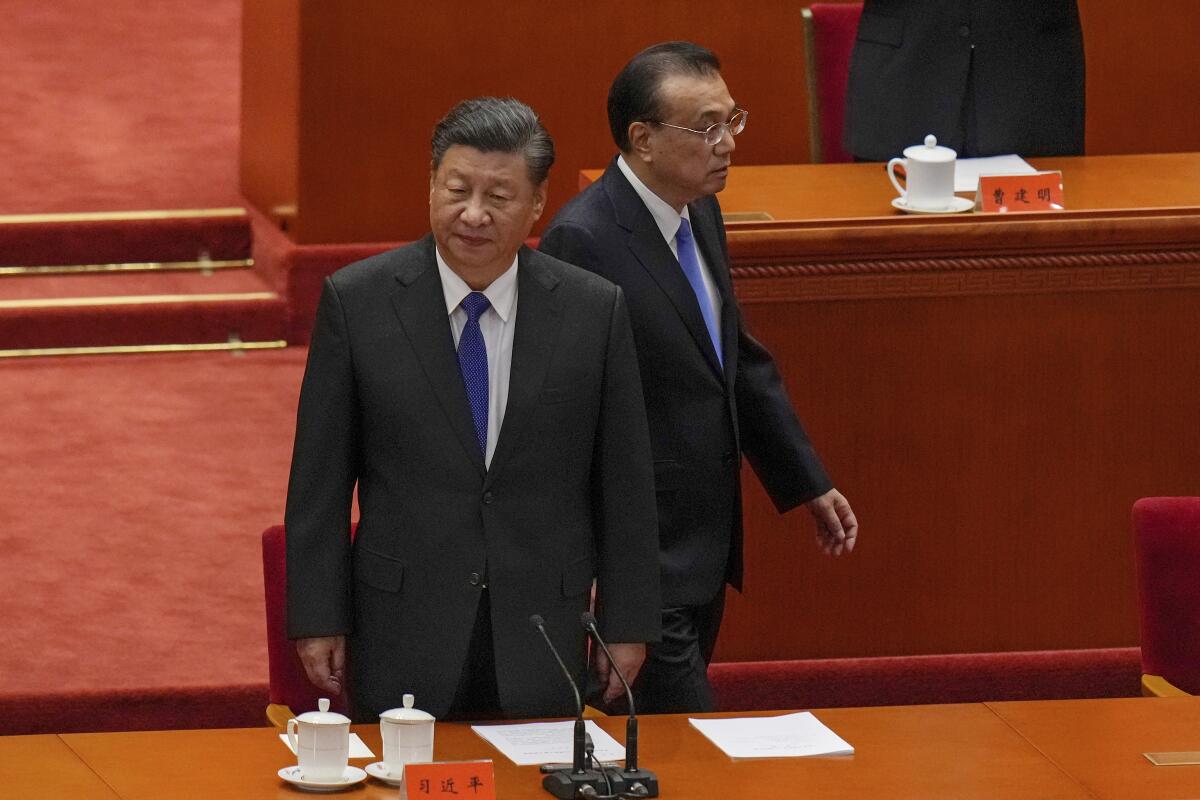
Woodroofe, the Asia Society fellow, said a more meaningful source of pressure on China may come from developing nations that are most vulnerable to climate change.
A major part of China’s assertive foreign policy under Xi has been to act as the leader of the developing world standing up to the United States and its allies. Many of the countries that Beijing invests in through its Belt and Road initiative have voted alongside China in the U.N. General Assembly on issues such as Hong Kong and Xinjiang. But now they want China to do more on climate change.
“For a lot of those countries, their survival frankly rests on the global climate fight, and Beijing holds the greatest keys to the success or otherwise of that fight,” he said. “That has changed the way a lot of these countries perceive China.”
Climate experts still hope global warming could be treated as a neutral ground for U.S.-China cooperation, especially in scientific research. Major strides in technologies such as clean energy storage and transmission are still needed.
“The world is really missing a big opportunity when the No. 1 and No. 2 powerhouses in science and technology aren’t able to cooperate with each other without deep suspicion,” said David Victor, a professor of innovation and public policy at the School of Global Policy and Strategy at UC San Diego.
Sam Geall, an expert on China and climate policies at the University of Sussex, said Washington and Beijing need to find a way to collaborate on global warming just as Washington and Moscow worked together to limit nuclear proliferation during the Cold War.
“This has a similar existential quality,” he said. “And it needs to be taken seriously in that way.”
Megerian reported from Washington and Su from Beijing.
More to Read
Get the L.A. Times Politics newsletter
Deeply reported insights into legislation, politics and policy from Sacramento, Washington and beyond. In your inbox three times per week.
You may occasionally receive promotional content from the Los Angeles Times.
